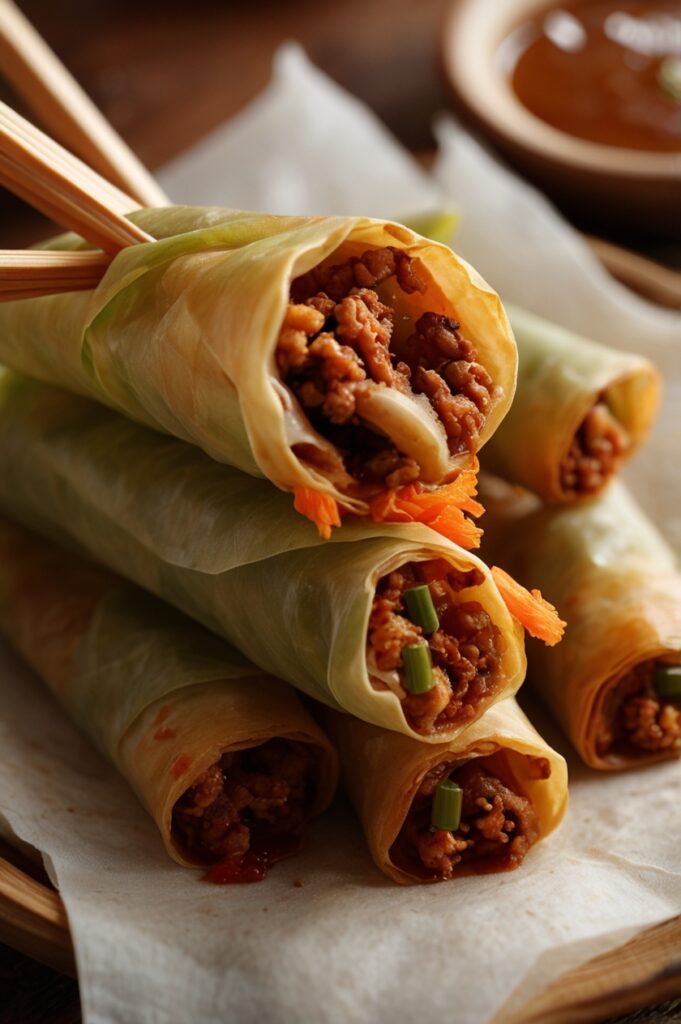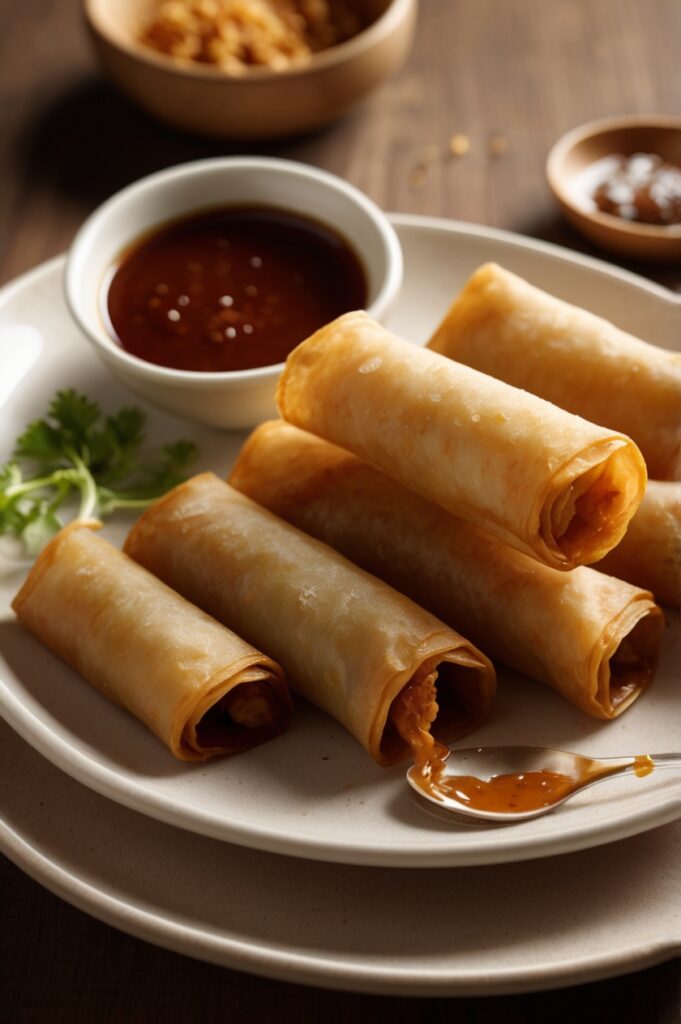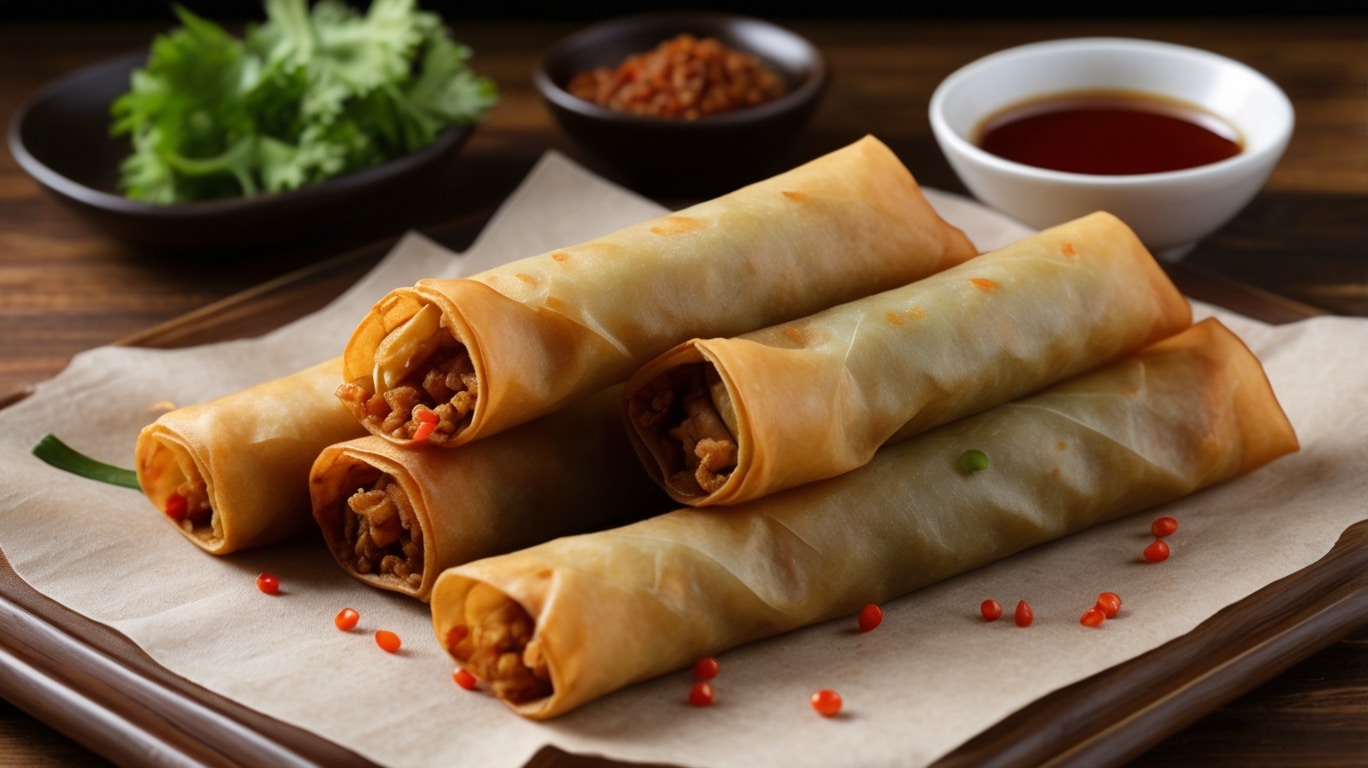Filipino Lumpia isn’t just a snack. It’s the thing that vanishes first at every Filipino party, always. My Tita Lucy used to hide a few behind the rice cooker just to make sure the family got some before the neighbors cleaned us out.
Filipino Lumpia is the Philippines’ answer to the spring roll—crisp, golden, impossibly addictive. What makes it different? The filling. Ground pork, carrots, onions, garlic, with just enough seasoning to make your eyes close with the first bite. No dipping sauce required—but you’ll want one anyway.
Filipino Lumpia carries stories. It’s what Lola made for birthdays, what Ate rolls before dawn for town fiestas, what you freeze by the dozens because one batch’s never enough. There’s technique involved, tradition, and yeah—a little bit of magic. Let’s get into the delicious guts of it.
Ingredients & Substitutions
Filipino Lumpia starts with quality ground pork — not too lean, not too fatty. You want some juiciness, but not a grease bomb. 80/20 ground pork is spot on.
- 1 lb ground pork (or sub with ground chicken or firm tofu for a lighter or vegetarian version)
- 1 cup finely shredded carrots
- 1 cup finely chopped green beans (snap beans work too)
- 1 small onion, minced fine (red onion if you want a sharper bite)
- 4 cloves garlic, crushed or grated
- 1 egg, for binding
- 2 tbsp soy sauce
- 1 tsp ground black pepper
- 1 tsp salt, but taste your filling raw before wrapping—yes, I said it
- Lumpia wrappers, about 25 (spring roll wrappers, not egg roll wrappers—they’re too thick)
- Oil, for deep frying (neutral oil like canola or peanut)
If you’re somewhere where lumpia wrappers are scarce, spring roll wrappers from Asian stores work—but not rice paper. Those are for fresh rolls, and you’ll end up with sad, chewy messes. You want thin, papery sheets that crisp like shattering glass.

Step-by-Step Instructions
Filipino Lumpia starts with mixing the filling—and here’s where most folks mess up. Don’t just dump and stir. You need to knead that mixture until it gets sticky. That’s how you know the proteins are binding. No binding = dry, crumbly rolls.
- Combine pork, veggies, garlic, onion, egg, soy sauce, salt, and pepper in a large bowl. Mix it like you mean it. Use your hands. No forks. No shame.
- Lay out your wrapper like a diamond, point facing you. Place a thin line of filling—no more than a tablespoon—about 2 inches from the bottom point. Shape it long and skinny.
- Fold the bottom up and over the filling, roll once, fold in the sides, and keep rolling tight. Dab a little water or egg wash on the edge to seal.
- Stack finished rolls under a damp towel or plastic wrap so they don’t dry out and crack. Cracked lumpia = oil explosion. You don’t want that.
- Heat oil in a deep pan or wok, medium-high, around 350°F (175°C). Drop lumpia in batches, don’t overcrowd or temp’ll drop and they’ll soak oil.
- Fry 3–5 minutes until golden brown, turning once or twice. Drain on paper towels. Listen for the crunch when you tap them. That’s the goal.
Filipino Lumpia can be baked, sure. But fried lumpia is fried lumpia. Baked ones taste… fine. But you’ll miss that party-snack crackle that only comes from oil.
Cooking Techniques & Science
Filipino Lumpia relies on balance—moist filling, dry skin, controlled oil heat. Too hot? Burnt outside, raw inside. Too cold? Greasy rolls. Temp is everything.
Kneading the filling develops myosin, a protein in meat. Myosin helps it hold together when cooked, creating that cohesive, juicy texture instead of crumbly bits falling out.
Rolling tightly is also non-negotiable. Loose lumpia trap steam, steam pops wrappers open, oil gets inside, and you got soggy logs.
Using spring roll wrappers instead of egg roll wrappers is critical. Egg roll skins puff and blister, and you want a smooth, glassy shell that snaps—not chews.
A wok or deep fryer works best. The lumpia need to float to cook evenly. If they’re touching the pan bottom, you risk uneven browning.
Freeze them raw, not cooked, if prepping ahead. They fry beautifully from frozen. Just add a minute or two to the fry time and don’t overcrowd the pan.
Serving & Pairing Suggestions
Filipino Lumpia is best hot, fresh out of the oil, served upright in a mug or laid out on banana leaves. No garnish needed. Just hands.
Sweet chili sauce is classic. A mix of vinegar, sugar, garlic, and chilies works if you’re making it yourself. Some folks use banana ketchup. Others mix soy sauce and vinegar with minced garlic for dipping. Try ’em all.
Serve with pancit bihon, Filipino fried noodles. Or garlic fried rice and fried eggs for a wicked brunch. Cold San Miguel beer? Yeah, don’t skip that.
Don’t refrigerate fried lumpia—they lose their snap. Reheat in the oven, not microwave. Or just fry fresh ones. You froze some, right?
Filipino Lumpia always disappears first. So make more. Always double the batch. You’ll thank yourself later.

Conclusion
Filipino Lumpia isn’t just a roll—it’s a ritual. A celebration of crunch, comfort, and a thousand rolled memories. Every Filipino knows the struggle of trying to eat just one. Impossible.
The beauty lies in the simplicity. It’s ground pork and veg, wrapped up and fried. But every step has to be right. The tight roll, the hot oil, the thin skin that shatters in your mouth.
Treat the lumpia with care, and it’ll give you back magic. You don’t need to be Filipino to master it—you just need patience, good music, and maybe someone to roll with you.
FAQs
Can I make Filipino Lumpia ahead of time?
Yes, absolutely. Make and freeze them before frying. They fry beautifully straight from frozen. Just add a minute or two to your cook time and keep the oil hot.
What’s the best wrapper to use for Filipino Lumpia?
Use Filipino-style spring roll wrappers—not egg roll or rice paper. They’re paper-thin, come frozen, and turn super crisp. If you can’t find those, go for Chinese-style spring roll wrappers as a backup.
Can I bake lumpia instead of frying?
You can, but they won’t be as crisp. Brush with oil and bake at 425°F (220°C) for 15–20 minutes, turning once. Still tasty, but not as deadly good as fried.
How do I keep the wrappers from tearing?
Keep the wrappers covered with a damp towel. Work fast. Don’t overfill. If a wrapper cracks, just toss it—trying to fix it is a slippery road to sadness.
What meats can I use in place of pork?
Ground chicken, turkey, or even shrimp works. Want veggie lumpia? Use chopped mushrooms and tofu with the same seasonings. Just make sure to squeeze out moisture so the rolls stay crisp.

Olivia P. is a seasoned food blogger at Tastywink, sharing delicious, easy-to-follow recipes inspired by him passion for home cooking. With years of culinary blogging experience, he brings flavor, creativity, and a personal touch to every dish.
